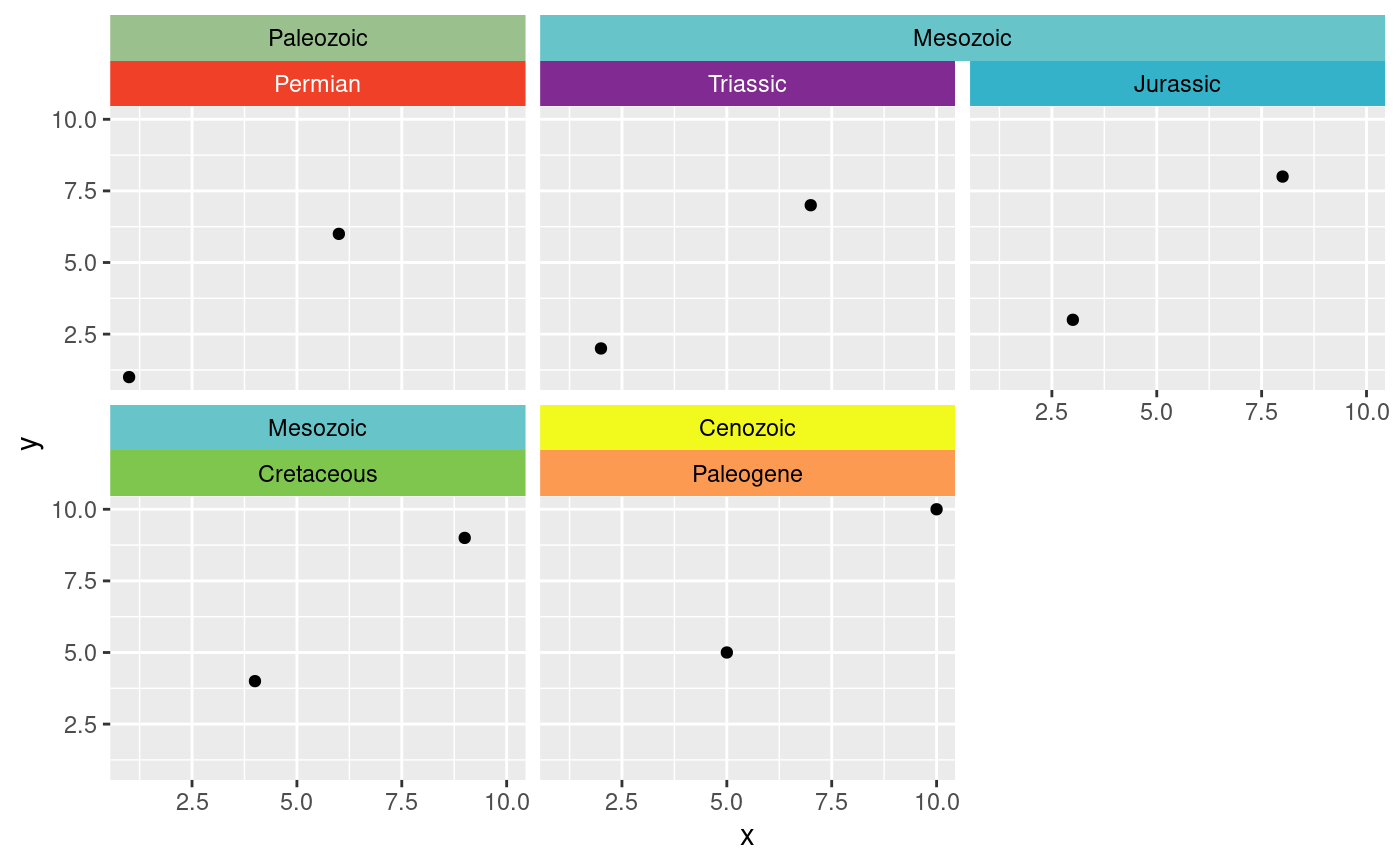facet_nested_wrap_color behaves similarly to ggh4x::facet_nested_wrap()
in that it wraps a sequence of panels onto a two-dimensional layout, and
nests grouped facets where possible.. The main difference is that it also
allows the user to specify the background and label colors of the individual
facet strips using the colors and lab_colors arguments.
Usage
facet_nested_wrap_color(
facets,
colors,
nrow = NULL,
ncol = NULL,
scales = "fixed",
axes = "margins",
remove_labels = "none",
shrink = TRUE,
labeller = "label_value",
lab_colors = "auto",
as.table = TRUE,
drop = TRUE,
dir = "h",
strip.position = "top",
nest_line = element_line(inherit.blank = TRUE),
solo_line = FALSE,
resect = unit(0, "mm"),
trim_blank = TRUE,
strip = strip_nested(),
bleed = NULL
)
facet_nested_wrap_geo(
facets,
colors = rbind(periods, stages),
nrow = NULL,
ncol = NULL,
scales = "fixed",
axes = "margins",
remove_labels = "none",
shrink = TRUE,
labeller = "label_value",
lab_colors = "auto",
as.table = TRUE,
drop = TRUE,
dir = "h",
strip.position = "top",
nest_line = element_line(inherit.blank = TRUE),
solo_line = FALSE,
resect = unit(0, "mm"),
trim_blank = TRUE,
strip = strip_nested(),
bleed = NULL
)Arguments
- facets
A set of variables or expressions quoted by
vars()and defining faceting groups on the rows or columns dimension. The variables can be named (the names are passed tolabeller).For compatibility with the classic interface, can also be a formula or character vector. Use either a one sided formula,
~a + b, or a character vector,c("a", "b").- colors
Specifies which colors to use to replace the strip backgrounds. Either A) a function that returns a color for a given strip label, B) the character name of a function that does the same, C) a named character vector with names matching strip labels and values indicating the desired colors, or D) a data.frame representing a lookup table with columns named "name" (matching strip labels) and "color" (indicating desired colors). If the function returns
NA, the default background color will be used.- nrow, ncol
Number of rows and columns.
- scales
A
character(1)orlogical(1)whether scales are shared across facets or allowed to vary. One of the following:"fixed"orFALSEScales are shared across all facets (default).
"free_x"x-scales are allowed to vary.
"free_y"y-scales are allowed to vary.
"free"orTRUEBoth scales can vary
- axes
A
character(1)orlogical(1)where axes should be drawn. One of the following:"margins"orFALSEOnly draw axes at the outer margins (default).
"x"Draw axes at the outer margins and all inner x-axes too.
"y"Draw axes at the outer margins and all inner y-axes too.
"all"orTRUEDraw the axes for every panel.
- remove_labels
A
character(1)orlogical(1)determining whether axis text is displayed at inner panels. One of the following:"none"orFALSEDisplay axis text at all axes (default).
"x"Display axis text at outer margins and all inner y-axes.
"y"Display axis text at outer margins and all inner x-axes.
"all"orTRUEOnly display axis text at the outer margins.
- shrink
If
TRUE, will shrink scales to fit output of statistics, not raw data. IfFALSE, will be range of raw data before statistical summary.- labeller
A function that takes one data frame of labels and returns a list or data frame of character vectors. Each input column corresponds to one factor. Thus there will be more than one with
vars(cyl, am). Each output column gets displayed as one separate line in the strip label. This function should inherit from the "labeller" S3 class for compatibility withlabeller(). You can use different labeling functions for different kind of labels, for example uselabel_parsed()for formatting facet labels.label_value()is used by default, check it for more details and pointers to other options.- lab_colors
Specifies which colors to use for the strip labels. Either A) a function that returns a color for a given strip label, B) the character name of a function that does the same, C) a named character vector with names matching strip labels and values indicating the desired colors, D) a data.frame representing a lookup table with columns named "name" (matching strip labels) and "lab_color" (indicating desired colors), or E) "auto" (the default), which set the labels to black or white, whichever has better contrast with the background color, based on recommendations by the International Telecommunication Union. If the function returns
NA, the default label color will be used.- as.table
If
TRUE, the default, the facets are laid out like a table with highest values at the bottom-right. IfFALSE, the facets are laid out like a plot with the highest value at the top-right.- drop
If
TRUE, the default, all factor levels not used in the data will automatically be dropped. IfFALSE, all factor levels will be shown, regardless of whether or not they appear in the data.- dir
Direction: either
"h"for horizontal, the default, or"v", for vertical.- strip.position
By default, the labels are displayed on the top of the plot. Using
strip.positionit is possible to place the labels on either of the four sides by settingstrip.position = c("top", "bottom", "left", "right")- nest_line
a theme element, either
element_blank()or inheriting fromggplot2::element_line(). Lines are drawn between layers of strips indicating hierarchy. The element inherits from theggh4x.facet.nestlineelement in the theme.- solo_line
A
logical(1)indicating whether parent strips with a single child should be drawn with anest_line(TRUE) or the line only applies to parents with multiple children (FALSE, default). Only relevant whennest_lineis drawn.- resect
a
unitvector of length 1, indicating how much the nesting line should be shortened.- trim_blank
A
logical(1). WhenTRUE(default), does not draw rows and columns containing no panels. WhenFALSE, thenrowandncolarguments are taken literally, even when there are more than needed to fit all panels.- strip
An object created by a call to a strip function, such as
strip_nested().- bleed
the
bleedargument has moved to thestrip_nested()function.
Details
facet_nested_wrap_geo(...) is an alias of facet_nested_wrap_color() with the
default of colors set to rbind(periods, stages).
See also
Other faceting functions:
facet_grid_color(),
facet_nested_color(),
facet_wrap_color()
Examples
library(ggplot2)
df <- data.frame(x = 1:10, y = 1:10,
period = factor(c("Permian", "Triassic", "Jurassic",
"Cretaceous", "Paleogene"),
levels = c("Permian", "Triassic",
"Jurassic", "Cretaceous",
"Paleogene")),
era = factor(c("Paleozoic", "Mesozoic", "Mesozoic",
"Mesozoic", "Cenozoic"),
levels = c("Paleozoic", "Mesozoic",
"Cenozoic")))
ggplot(df, aes(x, y)) +
geom_point() +
facet_nested_wrap_color(~ era + period, colors = rbind(periods, eras))

